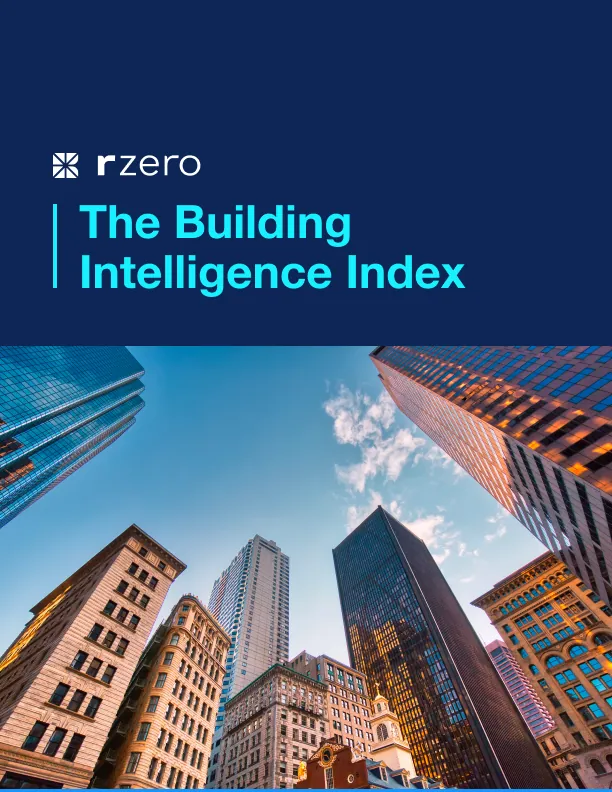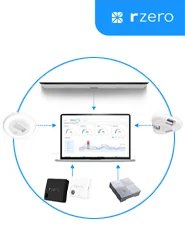
Creating Energy-Efficient Outcomes for Your Buildings
Q&A with R-Zero’s Matt Arneson
In honor of Earth Month, we sat down with our in-house expert in energy efficiency, Matt Arneson, to learn more about how customers can drive sustainable outcomes across their buildings.
Climate disclosure regulations, both domestic and international, seem to be in the news every week. Are building developers, owners, and operators feeling the pressure to act on these regulations now? Or are they taking a more phased approach to their emissions reduction strategy?
Matt: Companies are not only feeling the pressure from regulations, but also from consumers, investors, stakeholders, and employees to implement initiatives related to emissions reduction. With growing concerns about climate change and environmental sustainability, local, state, and federal governments around the world are rolling out stricter regulations to curb emissions from buildings. These regulations often include requirements for energy efficiency, renewable energy usage, and emissions reductions.
That said, an approach to compliance should vary by customer, taking into account factors like specific regulations in place, the industry sector, geographic location, and the size and resources of the organization. Some may feel compelled to act quickly to meet regulatory deadlines and avoid the penalties or reputational risks associated with non-compliance, while others may take a more phased approach, implementing changes gradually over time to minimize disruption to operations and manage costs more effectively.
Separately, some building developers, owners, and operators may proactively embrace sustainability measures beyond regulatory requirements, recognizing the long-term benefits of reducing emissions, such as cost savings, improved building performance, and enhanced market competitiveness.
You’ve worked in the energy efficiency industry for many years, what’s the number one question you hear from customers interested in creating more sustainable outcomes across their buildings?
Matt: Inevitably, the first, and therefore, the most important question I hear from customers is “where do we start?” This question reflects a genuine desire to act but often comes with a sense of overwhelm due to the complexity of sustainability initiatives and the myriad of options available. Customers are most interested in guidance on how to identify the most impactful strategies and technologies for their specific organizational needs.
There is no one right answer, but a common starting point is to conduct assessments to understand current performance and identify areas for improvement. This may involve analyzing energy usage, water consumption, workplace operational practices, indoor air quality, and other relevant factors.
Once the areas for improvement are identified, customers typically seek advice on prioritizing initiatives based on factors such as potential impact, feasibility, cost-effectiveness, and alignment with organizational goals. They may also inquire about available incentives, rebates, and financing options to support their sustainability efforts. Data is key to this prioritization process, but ultimately, customers want synthesis of that data into actionable insights and practical recommendations that will help them make meaningful progress towards their sustainability goals while also considering their operational and financial constraints.
What are a few myths about building energy-efficiency that you think need to be busted?
Matt: There are many myths and misconceptions around how or how not to make a building energy-efficient. But one that I hear often is that energy-efficient buildings result in sacrificing workplace comfort and health. In fact, energy-efficient buildings often feature advanced ventilation solutions and air filtration technologies that optimize air flow based on occupancy, which help maintain optimal indoor air quality. Proper ventilation reduces the concentration of pollutants, allergens, and pathogens, leading to healthier indoor environments for occupants.
Energy-efficient buildings may also have HVAC systems that provide more consistent temperature and humidity control throughout the workspace and adjust based on the changing needs of the building – whether that be occupancy, variable energy costs, or weather. This creates a comfortable indoor environment, while reducing the discomfort associated with temperature fluctuations and excessive humidity levels. The added benefit is that consistent comfort levels can improve occupant satisfaction and productivity.
Last but not least, do you have any Earth Day traditions you’ll be participating in this year?
Matt: Earth Day is a great reminder that we need to think beyond ourselves and how our actions impact both the world around us and our future generations. Being a parent, I like to focus on small, tangible behaviors both my family and I can do year round to be more environmentally conscious. Simple things like turning off lights when we aren’t in the room, turning off the water while brushing our teeth, or putting on a sweater rather than cranking up the thermostat. These are small behaviors that help build a mindset that thinks more sustainably, which can lead to even bigger ideas and impacts in our lives.
Start planning for energy-efficient outcomes with R-Zero
At R-Zero our goal is to create healthier and more responsive buildings by using intelligent solutions that optimize spaces for the benefit of people, energy, and sustainability. Check out our ROI & Sustainability Calculator today to see how our solutions can help you drive reductions in energy costs and GHG emissions.
More posts you might like
-

R-Zero Adds Energy-Efficient HVAC Filtration Technology with SecureAire Acquisition
Exciting news! R-Zero has announced its acquisition of SecureAire, bringing industry-leading, electrically-enhanced HVAC filtration technology into its decarbonization portfolio. With this acquisition, R-Zero strengthens its commitment to energy efficiency and superior indoor air quality. Why HVAC Filtration Matters for Energy Efficiency Traditional HVAC filtration systems, particularly those with a MERV 13 rating or higher, often […]
-

Indoor Air Quality and Energy Efficiency in Commercial Buildings
Over the last few years, access to clean indoor air has become essential for people that work inside of buildings like offices, hospitals, and schools. This has prompted organizations like ASHRAE and the CDC to introduce clean air targets to improve indoor health and comfort in buildings and encourage increased air ventilation, filtration, and use […]
-

Trends Driving Corporate Climate Strategies in 2024
Research firm Verdantix recently published a study surveying 353 global decision-makers, across 38 countries, on the key trends shaping their corporate climate change strategies in 2024. Currently, net zero targets cover a majority (92%) of global GDP. According to the study, prioritizing compliance, seeking competitive advantage, and aligning with stakeholder requirements are the top three […]

